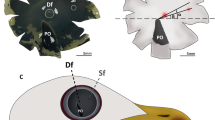Summary
With the aid of a microspectrophotometer the visual pigments and oil globules in the retina of the emu (Dromiceius novae-hollandiae), the brushland tinamou (Nothoprocta c. cinerascens) and the Chilean tinamou (Nothoprocta perdicaria sanborni) were characterized. All three of these palaeognathous birds contain in their rods a typical rhodopsin with λmax near 500 nm. Each of these birds has cones containing iodopsin-like visual pigments with λmax in the 560–570 nm spectral region. No unequivocal evidence was obtained for the presence of cone pigments other than this iodopsin-like pigment, although one cell thought to be a cone, and containing a visual pigment with λmax near 498 nm, was observed in the retina of the brushland tinamou. The oil globule systems of the three palaeognathous species are identical to each other and are much simpler than is typical for neognathous birds in that only two different types of globule are present, one with λT50 at 508 nm and another with λT50 at 568 nm. Comparison of the data with observations made on neognathous species indicates (1) that palaeognathous birds probably have poorer color discrimination capabilities than neognathous birds and (2) that the tinamou is more closely related to the ratites than to the galliform species.
Similar content being viewed by others
References
Bowmaker JK (1977) The visual pigments, oil droplets and spectral sensitivity of the pigeon. Vision Res 17:1129–1138
Bowmaker JK (1979) Visual pigments and oil droplets in the pigeon retina, as measured by microspectrophotometry, and their relationship to spectral sensitivity. In: Granda AM, Maxwell JH (eds) Neural mechanisms of behavior in the pigeon. Plenum, New York, pp 287–305
Bowmaker JK, Knowles A (1977) The visual pigments and oil droplets of the chicken retina. Vision Res 17:755–764
Bowmaker JK, Martin GR (1978) Visual pigments and colour vision in a nocturnal bird,Strix aluco (Tawny Owl). Vision Res 18:1125–1130
Bowmaker JK, Loew ER, Liebman PA (1975) Variation in the λmax of rhodopsin from individual frogs. Vision Res 15:997–1004
Cracraft J (1974) Phylogeny and evolution of the ratite birds. Ibis 116:494–521
Crescitelli F, Wilson BW, Lilyblade AL (1964) The visual pigments of birds. I. The turkey. Vision Res 4:275–280
Levine JS, Goodman SL, MacNichol EF Jr (1981) Cone pigments: aldehyde fixation for microspectrophotometry. Invest Ophthalmol Vis Sci Suppl 20:104
Liebman PA (1972) Microspectrophotometry of photoreceptors. In: Dartnall HJA (ed) Photochemistry of vision. Springer, Berlin Heidelberg New York (Handbook of sensory physiology, vol VII/1, pp 481–528)
Loew ER, Dartnall HJA (1976) Vitamin A1/A2-based visual pigment mixtures in cones of the rudd. Vision Res 16:891–896
Loew ER, Lythgoe JN (1978) The ecology of cone pigments in teleost fishes. Vision Res 18:715–722
Meyer DB (1977) The avian eye and its adaptations. In: Crescitelli F (ed) The visual system in vertebrates. Springer, Berlin Heidelberg New York (Handbook of sensory physiology, vol VII/5, pp 549–611)
Neumann G-H (1962) Das visuelle Lernvermögen eines Emus. J Ornithol 103:153–165
Prager EM, Wilson AC, Osuga DT, Feeney RE (1976) Evolution of flightless land birds on southern continents: Transferrin comparison shows monophyletic origin of ratites. J Mol Evol 8:283–294
Sibley CG, Frelin C (1972) The egg white protein evidence for ratite affinities. Ibis 114:377–387
Sillman AJ (1969) The visual pigments of several species of birds. Vision Res 9:1063–1077
Sillman AJ (1973) Avian vision. In: Farner DS, King JR, Parkes KD (eds) Avian biology, vol III. Academic Press, New York, pp 349–387
Wald G, Brown PK, Smith PH (1955) Iodopsin. J Gen Physiol 38:623–681
Wyszecki G, Stiles WS (1967) Colour science. Wiley, New York, p 584
Author information
Authors and Affiliations
Additional information
This study was supported, in part, by NIH Grant No. EY01839 (A.J. Sillman), NIH Grant No. EY00323 (W.N. McFarland) and NSF Grant No. 78-07657 (E.R. Loew). The authors thank E. Clinite, R. Dunford, C. Murphy, R. Riis and D. Weathers for their valuable assistance. Thanks also go to R.E. Burger for his gift of the emus.
Rights and permissions
About this article
Cite this article
Sillman, A.J., Bolnick, D.A., Haynes, L.W. et al. Microspectrophotometry of the photoreceptors of palaeognathous birds — the emu and the tinamou. J. Comp. Physiol. 144, 271–276 (1981). https://doi.org/10.1007/BF00612558
Accepted:
Issue Date:
DOI: https://doi.org/10.1007/BF00612558




